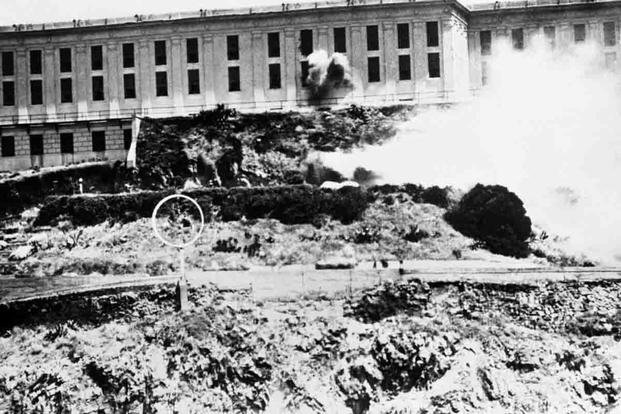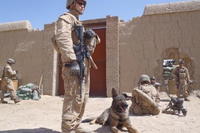Between 1934 and 1963, the country's most dangerous convicts were sent to an island prison in San Francisco Bay. Alcatraz Federal Penitentiary housed the 20th century's most notorious captured criminals, because it was believed that escape from "The Rock" was impossible.
Al Capone, George "Machine Gun" Kelly and gangster Mickey Cohen were a few of the high-profile residents of Alcatraz, but it was considered a prisoner's prison: a place where the most violent prisoners were sent.
Life on Alcatraz was orderly and monotonous, filled with routines as an attempt to teach the prisoners to follow the rules. Unfortunately, some of the prison guards also fell into routines. They eventually let their guard down and allowed the prisoners to take advantage, proving the old military adage, "Complacency Kills."
The result was a two-day gun battle between the federal government and prisoners on the island that forced United States Marines to fight the prisoners.

Prisoners at Alcatraz were often transferred there because they were escape risks. Many of them had made numerous escape attempts during their sentences, with varying degrees of success. But even those who were the worst prisoners at previous penitentiaries could earn privileges at Alcatraz.
Bernard Coy was one of those prisoners. He was in for committing a robbery in Georgia with a shotgun, but soon earned the prison job of cell-house orderly, a catchall that usually involves assisting an official or doing janitorial work. In this role, he had a lot more freedom of movement around the prison, which allowed him to observe the guards' habits.
Coy also detailed the flaws in the prison's security and devised a way to break into the prison's gun gallery, take down the guards and sail to San Francisco. With weapons in hand, he would need to gain access to the prison yard to make it to the dock and steal the only launch that connected Alcatraz to the rest of California. That was the plan, anyway.
He enlisted the help of three accomplices, Marvin Hubbard, Joseph Cretzer and Clarence Carnes. Hubbard was a lifelong criminal with a history of violent escape attempts, Cretzer was a high-profile bank robber, and Carnes was a petty criminal who was doing time for murder during a robbery. Two other inmates, Sam Shockley and Miran Thompson, would join them in their attempt.
All went according to plan -- at first. The prisoners overpowered a total of nine guards and gained access to the weapons. All they had to do was find the right key that would open the door from the cell block to the yard. In trying the number of keys they found on the prison guards, they inadvertently jammed the lock. Even if they found the right key, the door couldn’t be opened.
Now trapped inside the cell block and with prison alarms blaring, Cretzer tried to kill their hostages, who were locked in a cell, so they couldn't testify as witnesses. Carnes, Shockley and Thompson went back to their cells, but the other three were going to try to shoot their way out. They didn't have to wait long.

The prisoners started firing on the outside guard towers. When armed officers tried to assault their position in the cell block, the three remaining prisoners returned fire. The firefight was so intense that one officer died and four others were wounded. The warden called in the Marines.
Two platoons of veteran Marines, who had experience fighting in the Pacific Theater of World War II, were shipped in to help the guards retake the prison from the convicts. In the time it took to get the Marines to Alcatraz, the prisoners had moved to the cell-block tower, a perfect firing position on any assault they might make.
While it might have given the prisoners hope that they couldn't be shot, they failed to move the hostages with them. When the hostages were finally removed from the prison battlefield, most still alive, it gave the government forces the ability to open up with more than small arms.
The Marines began using tactics they learned while fighting fortified Japanese positions during the island-hopping campaigns of World War II. Using machine guns and grenades, they pushed the convicts back from most of the cell-block tower and into areas that offered little maneuverability.

The next day, the Marines fired into the few remaining corridors controlled by the armed convicts in an almost unending hailstorm of bullets that lasted more than nine hours. In the morning, armed officers repeatedly assaulted the final hallway where the cons were holed up. Eventually, they killed the three remaining men, Cretzer, Hubbard and Coy, the ringleader.
Two prison guards were killed in the battle, with 14 more wounded. Two of the prisoners who gave up after the lock to the yard door was broken, Shockley and Thompson, were executed in a gas chamber for their role in the attempt. Carnes was given another life sentence.
-- Blake Stilwell can be reached at blake.stilwell@military.com. He can also be found on Twitter @blakestilwell or on Facebook.
Want to Learn More About Military Life?
Whether you're thinking of joining the military, looking for post-military careers or keeping up with military life and benefits, Military.com has you covered. Subscribe to Military.com to have military news, updates and resources delivered directly to your inbox.















